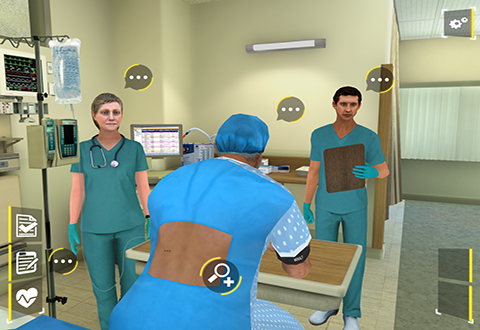Simulation-Based Strategies

A virtual reality simulation application to teach pre-procedure timeouts, developed in conjunction with NCPS, is already publicly available for use on the iPhone and iPad through Apple’s app store and iTunes. This free application can be found by searching for “VA Time Out” in Apple’s app store.
Simulation-Based Strategies to Teach the Universal Protocol and Timeouts for Invasive Procedures Occurring Outside the Operating Room
Robert Kononowech, M.S., MPH and Douglas Paull, M.D., MPH, VA National Center for Patient Safety
Incorrect procedures (wrong site, wrong side, wrong patient, wrong procedure, wrong implant, etc.), although infrequent, have the potential to cause devastating consequences to patients, families, providers, and health care organizations. The Joint Commission’s Universal Protocol remains the gold standard in the prevention of incorrect procedures.1 An integral part of the Universal Protocol is conducting a pre-procedure “timeout” immediately prior to the start of the procedure. The timeout allows staff to verify the patient’s identity, the procedure to be performed and the procedure site; it also affords staff the opportunity to certify the informed consent and review pertinent medical images. However, despite the importance of pre-procedure timeouts as a patient safety tool and a VHA policy requiring a timeout before any invasive procedure2, compliance with timeouts outside the operating room (OR) has been an ongoing issue.3 This is believed to be due, in part, to a lack of training and awareness of timeout procedure and policy.
Current training on timeouts for medical residents in VA consists of a short, one-time didactic module. Simulation training presents a possible alternative educational format for teaching timeouts to physicians and other health care professionals in the Veterans Health Administration. For several years, the VA National Center for Patient Safety (NCPS) has used high-fidelity simulation utilizing advanced simulation mannequins and patient safety faculty experts to teach various patient safety concepts. This instruction includes teamwork and communication techniques as part of our Clinical Team Training curriculum. Additionally, high-fidelity simulation has also been utilized to teach the concepts of pre-procedure timeouts outside of the OR. However, high-fidelity simulation can be time and resource intensive – requiring the use of dedicated simulation space, expensive simulation equipment and trained faculty to facilitate the simulation scenario.
An alternative to high-fidelity simulation is virtual patient simulation, which is an interactive computer-based clinical simulation learning format. Virtual patient simulation scales well to large numbers of users because it does not require the use of dedicated space or faculty; it is highly customizable, and allows for much greater flexibility for the learner (can be used on a smartphone or tablet at the user’s convenience). Research conducted by Paull et al. at NCPS compared the effectiveness of virtual patient simulation to high-fidelity simulation in teaching pre-procedure timeouts. It was found that virtual patient simulation was on par with high-fidelity simulation in terms of realism and improving confidence of the learner.4
In 2015, NCPS was the recipient of a Department of Defense funded research grant to study the comparative effectiveness of different learning formats, specifically virtual patient simulation and high-fidelity simulation. The purpose was to teach the Universal Protocol and pre-procedure timeouts to VA health care professionals who work outside of the operating room. This study randomized learners to either a didactic education format (reading an article about timeouts), virtual patient simulation, or high-fidelity simulation and then compared their performance on a standardized patient scenario one to two weeks after training. During the standardized patient scenario, participants were expected to follow the steps of the Universal Protocol and conduct a pre-procedure timeout prior to a mock paracentesis. Their performance was evaluated and scored by trained raters using a clinical teamwork scale and an ensuring correct procedures checklist. A pre- and post-training survey and knowledge test were also administered to collect data on the participants’ knowledge of timeouts and their perceptions/confidence in performing them.
Preliminary analysis of the results has shown that high-fidelity simulation outperforms traditional didactic learning and virtual patient simulation in improving timeout performance. Virtual patient simulation did not significantly outperform traditional didactic learning in terms of timeout performance, but it did perform on par with the other learning formats in improving learner confidence and knowledge of timeouts. Virtual simulation thus has a potential to supplement other learning formats. More research is needed to examine the comparative effectiveness of more robust forms of virtual simulation, such as virtual reality simulation and virtual gaming to teach pre-procedure timeouts and other patient safety principles.
A virtual reality simulation application to teach pre-procedure timeouts, developed in conjunction with NCPS, is already publicly available for use on the iPhone and iPad through Apple’s app store and iTunes. This free application can be found by searching for “VA Time Out” in Apple’s app store.5 This application can serve as a ready to go patient safety education tool for interested parties in the VA health care system. Patient safety professionals and clinical leadership in VA should strongly consider the potential benefits of simulation, including virtual simulation, when examining ways to improve and enhance their patient safety education efforts.
References
1. Norton E. Implementing the universal protocol hospital-wide. AORN Journal 2007;85(6):1187-1197.
2. VHA Directive 1039. Ensuring Correct Surgery and Invasive Procedures: https://www.va.gov/vhapublica-tions/ViewPublication.asp?pub_ ID=2922
3. Neily J et al. Incorrect surgical procedures within and outside of the operating room. Arch Surg 2009;144(11):1028-1034.
4. Paull, D.E., Williams, L.C., Sine, D.M. (2016). Simulation Techniques for Teaching Time-Outs: A Controlled Trial. Patient Safety and Quality Healthcare, 13, 28-37.
5. Clinispace (2016). Time-Out Training (Version 1.0) [Mobile application software]. Retrieved from https:// itunes.apple.com/us/app/time-out-training/id1069292057?mt=8#



















